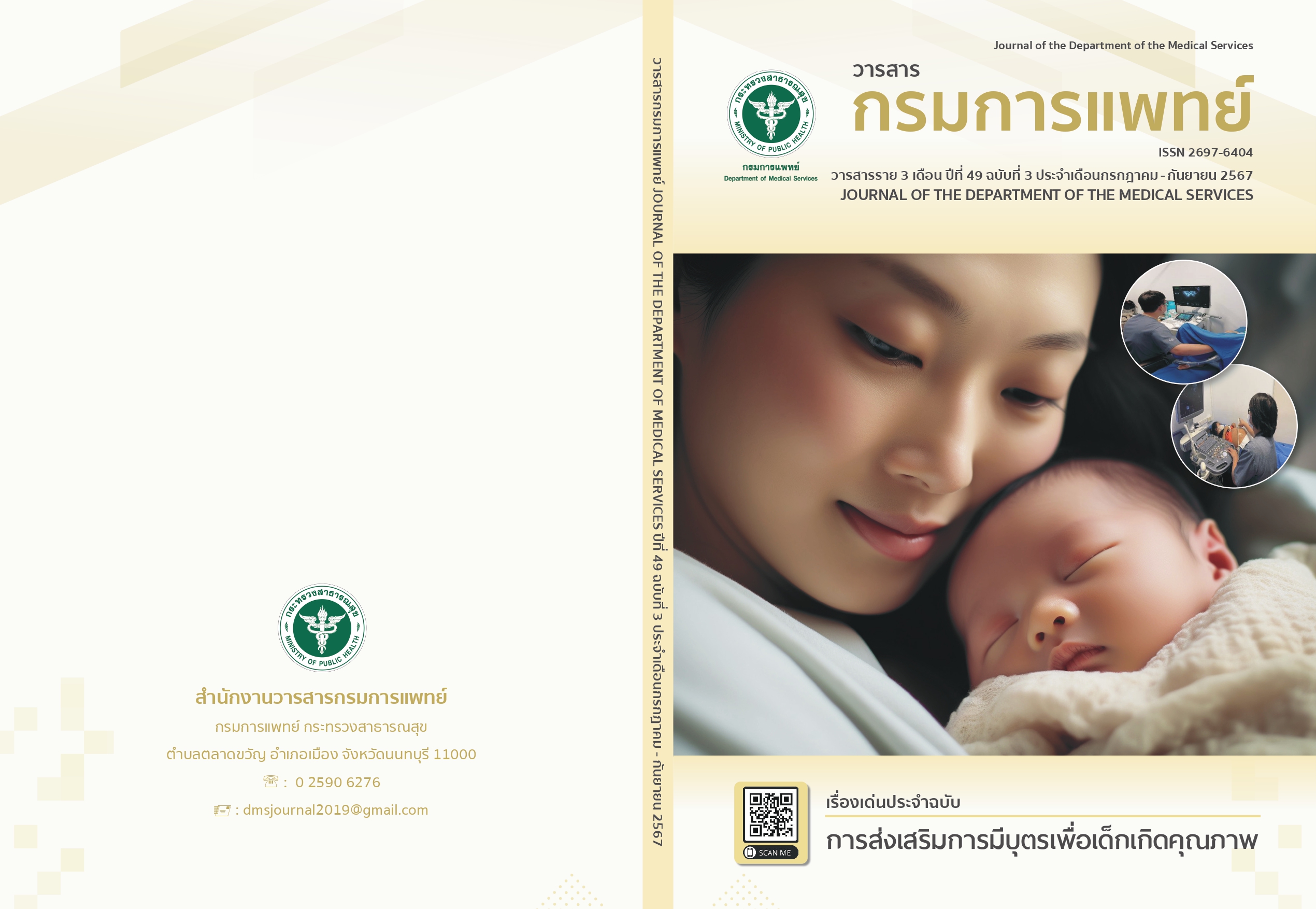Effect of Implementing a Palliative Cancer Care Guideline on Patient Care Outcomes and Caregiver Satisfaction
Keywords:
Palliative care guideline, Palliative care, Caregiver satisfactionAbstract
Background: Cancer is a major public health problem and a chronic disease that requires long-term and continuous treatment. This group of patients needs to receive supportive management of uncomfortable symptoms. In addition, patients and caregivers should be prepared during treatment for home-based continuing care. Objective: The study aimed to evaluate the effect of a palliative care guideline for cancer patients on the outcomes of care and caregiver satisfaction. Method: The study was a quasi-experimental study using the World Health Organization's palliative care framework for end-stage cancer patients, which consists of six domains: 1) Patient and family-centered care, 2) Comprehensive care, 3) Continuous care, 4) Interdisciplinary care, 5) System-strengthening care and 6) Quality of life promotion for patients and families. The sample consisted of 100 cancer patients diagnosed with a need for end-of-life palliative care and 100 caregivers. The research instrument was the Guideline for Palliative Cancer Care of Lampang Cancer Hospital. The data collection instruments were the Palliative Care Outcome Scale (POS) and the FAMCARE-2 caregiver satisfaction survey. The content validity index (CVI) was 0.98. The reliability of the questionnaire was assessed using Cronbach's alpha coefficient of 0.932. Data were analyzed using content analysis, descriptive statistics, and the Wilcoxon signed-rank test to compare the palliative care outcomes of the patients. Results: The study found that after using the palliative care guidelines, the outcomes for patients were significantly better than before using the guidelines (p-value <.001). Additionally, caregivers were highly satisfied with the care (mean = 4.52, SD = 0.34.). Conclusion: This palliative care guideline has led to improved care outcomes and caregiver satisfaction. It should be disseminated to other organizations so that it can be used to benefit the care of cancer patients.
References
Bray F, Ferlay J, Soerjomataram I, Siegel RL, Torre LA, Jemal A. Global cancer statistics 2018: GLOBOCAN estimates of incidence and mortality worldwide for 36 cancers in 185 countries. CA Cancer J Clin 2018;68(6):394-424.
Strategy and planning division. Public Health Statistics A.D. 2021 [e-book]. Nonthaburi: Ministry of Public Health; 2022 [cited 2022. Available from: https://spd.moph.go.th/wp-content/uploads/2022/11/Hstatistic64.pdf.
Pongnikorn D, Daoprasert K, Wongkaw B, Sangkam S, Praditkay M, Meemark S. Trends in cancer incidence and mortality in the northern region. 1993-2017: Effects of the Development of a Population-Level Cancer Registry Network. Lampang Cancer Hospital; 2020.
Strategy and Planning Division. Operational plan of the Department of Medical Services. [Internet]. Nonthaburi: Strategy and Planning Division of Department of Medical; 2019 [cited 2022 October 25]. Available from: https://www.dms.go.th/AboutUs/About_Strategy.
Naranjo LVG, Valencia. MMA. Humanized care: the case of patients subjected to chemotherapy. Invest Educ Enferm 2013;31(3):364-76.
Sirisoongnern J, Phimphisutiphong M, Phakdeekul W. Palliative and end of life care model in Khon Kaen province. Community Health Development Quarterly Khon Kaen University 2018;6(2):317-35.
Nursing unit promotes quality of life. Statistics on nursing practice promoting quality of life, Lampang Cancer Hospital, 2019-2021. Lampang; 2021.
Sapinun L. Manual for the use of the palliative care outcome assessment form (Palliative care Outcome Scale: POS). Chiang Mai: Klang Wiang Printing; 2013.
Sapinun L. Suandok's Palliative care model. [Internet]. 2016 [cited 2022 Jan 5]. Available from: https://ppi.psu.ac.th/upload/forum/7_Suandok_s_Palliative_care_model_5.60.pdf.
promdee A, Chantham N, Pewthong M. Results of the practice of palliative care approach of Mukdahan Hospital. Journal of Environmental and Community Health 2020;5(3):119-28.
Sujaritwarakul M. Effects of the Palliative Care Guideline on Quality of life and Palliative Care Outcome Scale in Care givers, Chonburi Hospital. Chonburi Hospital Journal 2019;44(2):97-108.
Boonyoung S, Wisai K. Palliative Outcome Score, Stress and Depression of the Caregiversafter Implemented Home-Based Palliative Care Guideline among Terminally Ill Patients of Primary Care Network, Phrao District, Chiang Mai Province. Lanna Public Health Journal 2020;16(2):104-17.
Jaturapatporn D. Patient care during last hours. [Internet]. [cited 2024]. Available from: https://www.rama.mahidol.ac.th/fammed/th/palliativecare/symptoms/doctorpalliative16th.
Chantharasena N, sakolnakorn PPn. The Development Of Palliative Care System Nonghan Hospital Nonghan District, Udonthani. [Internet]. 2018 [cited 2022 October 25]. Available from: http://203.157.168.38/web/r2r/data/CA0391.pdf.
Akkadechanunt T, Phornphibul P. Effectiveness of using clinical practice guidelines. for palliative care in cancer patients. Nursing Journal 2018;45(3).
Downloads
Published
How to Cite
Issue
Section
License
Copyright (c) 2024 Department of Medical Services, Ministry of Public Health

This work is licensed under a Creative Commons Attribution-NonCommercial-NoDerivatives 4.0 International License.
บทความที่ได้รับการตีพิมพ์เป็นลิขสิทธิ์ของกรมการแพทย์ กระทรวงสาธารณสุข
ข้อความและข้อคิดเห็นต่างๆ เป็นของผู้เขียนบทความ ไม่ใช่ความเห็นของกองบรรณาธิการหรือของวารสารกรมการแพทย์



